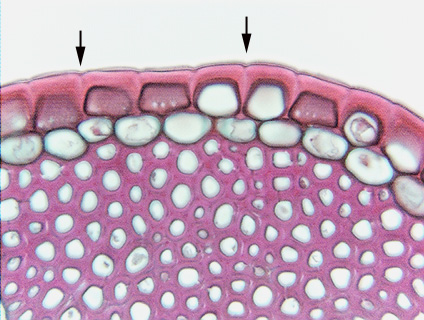 Fig.
10.2-13. Transverse section of yucca leaf (Yucca).
These epidermis cells have a very thick deposit of cutin,
and it even penetrated into the radial walls (the walls that run from
the inner side of the cell to the outer side), even extending down to the inner
wall. The two arrows indicate pale lines in the cuticle: such lines usually mean
that the cells are actually cuboidal, and that the outer wall and the outer
parts of the radial walls have thickened and are now encrusted with cutin.
(Alternatively, the cells could be rounded, with so much cutin that it has
filled in all the valleys between cells; but when that happens, there are no
pale lines.)
Fig.
10.2-13. Transverse section of yucca leaf (Yucca).
These epidermis cells have a very thick deposit of cutin,
and it even penetrated into the radial walls (the walls that run from
the inner side of the cell to the outer side), even extending down to the inner
wall. The two arrows indicate pale lines in the cuticle: such lines usually mean
that the cells are actually cuboidal, and that the outer wall and the outer
parts of the radial walls have thickened and are now encrusted with cutin.
(Alternatively, the cells could be rounded, with so much cutin that it has
filled in all the valleys between cells; but when that happens, there are no
pale lines.)